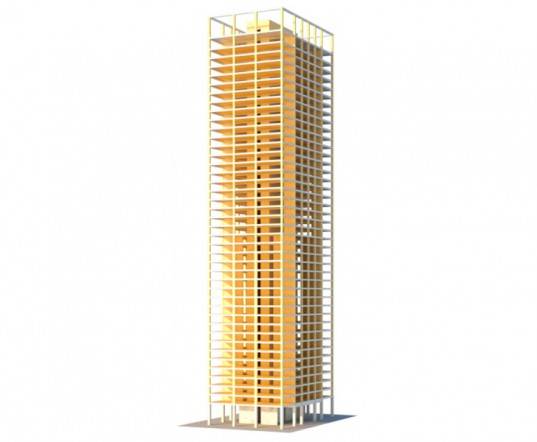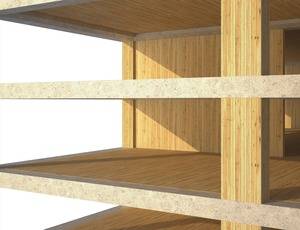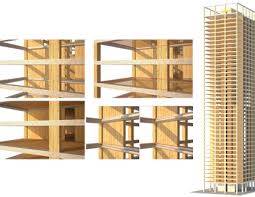SOM realizza il Timber Tower Research Project
Un progetto per stabilire la fattibilità strutturale di una torre a telaio in legno di 42 piani..
Skidmore Owings & Merrill LLP (SOM) realizza il Timber Tower Research Project, un'iniziativa promossa dal Softwood Lumber Board (SLB) per valutare la fattibilità strutturale di un edificio-torre realizzato in legno di 42 piani.
 The structural solution is benchmarked against the existing concrete-framed DeWitt Chestnut Apartments in Chicago—a revolutionary structural solution when it was designed by SOM in 1965. The new prototype is a hybrid system that uses the most efficient structural combination of mass timber, concrete and steel to reduce the carbon footprint of the resulting design by between 60 and 75 percent when compared to the concrete benchmark.
The structural solution is benchmarked against the existing concrete-framed DeWitt Chestnut Apartments in Chicago—a revolutionary structural solution when it was designed by SOM in 1965. The new prototype is a hybrid system that uses the most efficient structural combination of mass timber, concrete and steel to reduce the carbon footprint of the resulting design by between 60 and 75 percent when compared to the concrete benchmark.
The genesis of the project lies in the fact that a tall building’s embodied carbon footprint is significantly higher relative to low-rise buildings on a per square foot basis. This is exacerbated by the fact that tall buildings are almost exclusively constructed of concrete or steel—high-strength non-combustible materials that have a high carbon footprint when compared to wood. “The wood solution for sustainable tall buildings is attractive, but also requires care from the engineering community since few contemporary precedents exists,” according to the report’s executive summary. “The goal of the Timber Tower Research Project was to develop a structural system for tall buildings that uses mass timber as the main structural material and minimizes the embodied carbon footprint of the building,” SOM Managing Partner Richard F. Tomlinson II says.
The 400-feet-tall, 42-story building documented in the 72-page report and 33 supporting drawings demonstrate the technical feasibility of meeting architectural, structural, interior, and building service requirements. Systems were developed by SOM with considerations of constructability, cost and fire protection in mind—although additional research and physical testing will be necessary to verify the performance of the proposed system.


Contemporary building codes, based on prescriptive rather than performative requirements, generally limit wood-framed buildings to four-stories or less. Many architects, including SOM, are looking for an approach that allows safe, well-engineered large-scale wood buildings that responsibly address sustainable issues in our constructed environments. When SOM designed the John Hancock Center in the late 1960s, the Chicago Building Code did not allow for a 100-story building. The firm’s architects and engineers worked with the building department and elected leaders to develop safe and sensible solutions that set new standards. The Timber Tower Research Report can help inspire forward-thinking municipalities to create large buildings that address today’s concerns about sustainability.
Skidmore, Owings & Merrill has been at the forefront of designing and engineering tall buildings for more than half a century. Innovative structural systems such as the trussed tube (John Hancock Center), bundled tube (Willis—formerly Sears—Tower) and the buttressed core (Burj Khalifa) have been developed through the close coordination of the firm’s architects, interior designers, civil, mechanical and structural engineers. Structural efficiency is key to the success of a tall building system and the structural materials used in a tower must be used in a manner that capitalizes on the strengths of each. For the prototype timber tower, the SOM team developed a ‘concrete jointed timber frame’ structural system. “The development of the ‘concrete jointed timber frame’ system is a natural extension of our structural legacy,” Structural and Civil Engineering Partner William F. Baker, PE, SE, FASCE, FIStructE, says. “Building tall creates desirable urban density, but this solution helps us achieve this result with a much smaller carbon footprint.”
“Building sustainable cities is the most important design challenge of the 21st century,” SOM City Design Practice Partner Philip Enquist, FAIA, says. “Mass timber towers like those proposed in the Tall Timber Research Project will give us another important tool for environmentally responsible development in this century of cities.”
“The real work begins now that the report has been issued,” SOM Associate Benton Johnson says. “We think acceptance of tall timber structures will only continue to grow as the public learns more about the sustainability, fire resistance, and durability of all timber structures.”
SOM gratefully acknowledges funding for the Timber Tower Research Project from the Softwood Lumber Board. “This has been a team effort between our organization and SOM,” SLB Chief Executive Officer Steve Lovett says. “Mass timber has the inherently sustainable qualities necessary for contemporary construction and we welcome research that demonstrates its application in a wider variety of structures.” SOM would also like to thank other organizations and individuals who provided technical input or review for the project: Anthony Forest Products Co.—Aubra Anthony, Jr., Kerlin Drake, and Jeff Stefani; American Wood Council—Robert Glowinski and Brad Douglas; FP Innovations—Erol Karacabeyli; Idaho Forest Group—Marc Brinkmeyer; Structurlam—Bill Downing and Kris Spickler; Shen Milsom & Wilke, LLC—Erik Ryerson; The University of Queensland—Jose Torero; WoodWorks—Cheryl Ciecko and Scott Lockyear; and Dr. Nick Isyumov.
About Skidmore Owings & Merrill LLP
Skidmore, Owings & Merrill LLP (SOM) is one of the leading architecture, interior design, engineering, and urban-planning firms in the world, with a 75-year reputation for design excellence and a portfolio that includes some of the most important architectural accomplishments of the 20th and 21st centuries. Since its inception, SOM has been a leader in the research and development of specialized technologies, new processes and innovative ideas, many of which have had a palpable and lasting impact on the design profession and the physical environment. The firm’s longstanding leadership in design and building technology has been honored with more than 1,700 awards for quality, innovation, and management. The American Institute of Architects has recognized SOM twice with its highest honor, the Architecture Firm Award—in 1962 and again in 1996. The firm maintains offices in New York, Chicago, San Francisco, Los Angeles, Washington, D.C., London, Hong Kong, Shanghai, Mumbai and Abu Dhabi.
